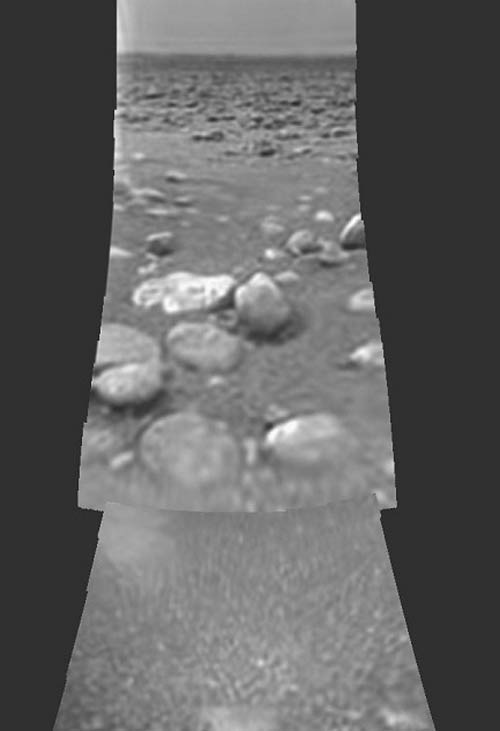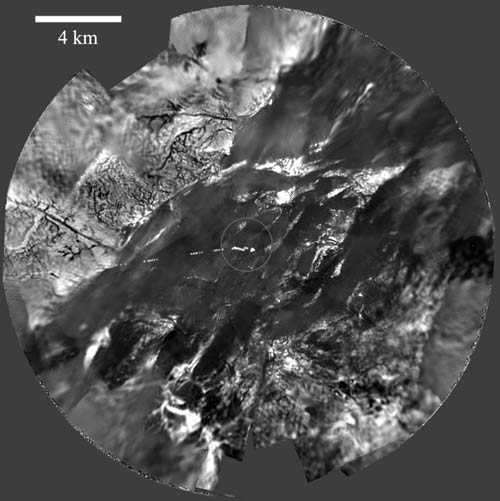Key Takeaways:
The European Space Agency’s Huygens probe reached Saturn’s moon Titan January 14. In the months since, planetary scientists have analyzed reams of data, trying to make sense of this giant moon (3,200 miles [5,150 kilometers] in diameter) — the only one in the solar system with a thick atmosphere. Researchers presented their latest results at a press conference November 30 in Paris.
The probe landed on Titan’s surface after a 2-hour-and-28-minute parachute descent through its haze-shrouded, nitrogen-rich atmosphere. Images of the surface show a world that resembles Earth in many ways, with structures that appear to be carved by flowing liquid — although in Titan’s case, the liquid is probably methane. The probe descended over a boundary between bright icy terrain and a darker area that looks like a dry lakebed. The probe landed in the dark area, where pebbles of water ice stretch to the horizon.
Working with scientists on Huygens sister spacecraft, the Saturn-orbiting Cassini, members of the Descent Imager/Spectral Radiometer (DISR) team pinpointed the landing site to within 3 miles (5 km). The probe landed at 192.3° west longitude and 10.3° south latitude. “It’s important that we know from an orbital perspective what kind of terrain the Huygens probe landed in,” says DISR team member Bashar Rizk of the University of Arizona’s Lunar and Planetary Laboratory. “It allows us to connect what Huygens found in detail about a small patch of Titan’s surface to what the orbiter is accumulating now.”
The DISR images reveal two types of channel networks carving the surface. The steeply sloped main drainage channels — about 300 to 650 feet (100 to 200 meters) wide and 150 to 300 feet (50 to 100 meters) deep — branch throughout the bright highland areas. Scientists think rapidly flowing rivers of liquid methane cut them. The second type are short, stubby channels that often begin or end in dark circular areas. The scientists think these channels are fed by springs.
The surface itself appears to be relatively soft, resembling wet clay. Researchers have backed off their initial interpretation that the surface has a thin, hard crust, which they likened to crème brûlée. Instead, they think the probe’s penetrometer first struck a hard pebble before digging in 4 inches (10cm).
Huygens’ analysis of Titan’s atmosphere shows it contains no xenon or krypton, noble gases that should be present if the atmosphere had not changed since the moon’s early days. This means its current nitrogen-rich atmosphere didn’t begin that way. Instead, scientists think Titan’s nitrogen evolved from a early atmosphere consisting mostly of ammonia — the same way Earth’s nitrogen atmosphere apparently developed.
The second-most abundant gas in Titan’s atmosphere is haze-causing methane, and scientists now believe it comes from geological activity in the moon’s interior. The amount of atmospheric methane near the surface is about 5 percent, some 3 times higher than in the moon’s stratosphere. This confirms the methane condenses near the surface.
Methane is broken down by sunlight and particles from space. If surface lakes and pools were the only sources of atmospheric methane, all of Titan’s methane would have been lost within 100 million years — a brief flash in the moon’s 4.5-billion-year history. So, the scientists conclude internal geological activity must drive methane to the surface and then into the atmosphere, where it rains down to form Titan’s varied surface features.











